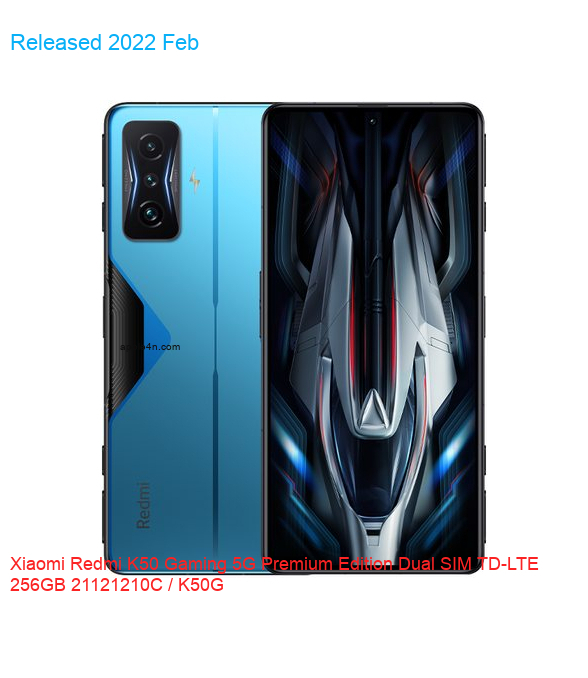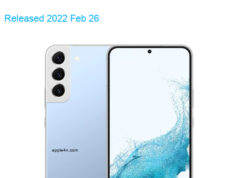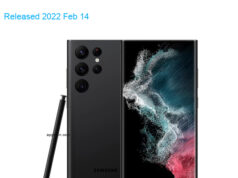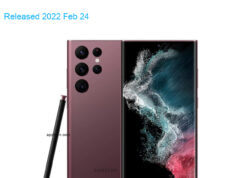| Brand | Xiaomi |
| Model | Redmi K50 Gaming 5G Premium Edition Dual SIM TD-LTE 256GB 21121210C / K50G |
| Released | 2022 Feb |
| Announced | 2022 Feb |
| Hardware Designer | Xiaomi |
| Manufacturer | Foxconn |
| Codename | Xiaomi Ingres |
| General Extras | Haptic touch feedback , Tactile touch feedback |
| Device Category | Smartphone |
| Width | 76.7 mm |
| Height | 162.5 mm |
| Depth | 8.5 mm |
| Dimensions | 3.02×6.4×0.33 inches |
| Mass | 210 g |
| Platform | Android |
| Operating System | Google Android 12 (S) |
| Software Extras | Voice Command , Business card recognition , Navigation software , Augmented Reality (AR) , Intelligent personal assistant , Voice Recognition , Face Recognition |
| CPU Clock | 2995 MHz |
| CPU | Qualcomm Snapdragon 8 Gen 1 5G SM8450 (Waipio), 2021, 64 bit, octa-core, 6144 Kbyte L3, 4 nm, Qualcomm Adreno 730 GPU |
| RAM Type | LPDDR5 SDRAM |
| RAM Capacity (converted) | 12 GiB RAM |
| Non-volatile Memory Interface | UFS 3.1 2-lane |
| Non-volatile Memory Capacity (converted) | 256 GB ROM |
| Display Hole | 1-hole |
| Display Diagonal | 169.4 mm |
| Resolution | 1080×2400 |
| Horizontal Full Bezel Width | 7.18 mm |
| Display Area Utilization | 86.2% |
| Pixel Density | 395 PPI |
| Display Type | AM-OLED display |
| Number of Display Scales | 1073.7M |
| Display Refresh Rate | 120 Hz |
| Scratch Resistant Screen | Gorilla Glass Victus |
| Graphical Controller | Qualcomm Adreno 730 |
| GPU Clock: | 818 MHz |
| A/V Out | No |
| Microphone(s) | 3 |
| Loudspeaker(s): | 4 |
| Audio Output: | USB Type-C |
| Supported Cellular Bands | GSM850 , GSM900 , GSM1800 , GSM1900 , UMTS2100 (B1) , UMTS1900 (B2) , UMTS1700/2100 (B4) , UMTS850 (B5) , UMTS800 (B6) , UMTS900 (B8) , UMTS800 (B19) , CDMA800 (BC0) , LTE2100 (B1) , LTE1900 (B2) , LTE1800 (B3) , LTE1700/2100 (B4) , LTE850 (B5) , LTE2600 (B7) , LTE900 (B8) , LTE800 (B18) , LTE800 (B19) , LTE850 (B26) , TD-LTE2000 (B34) , TD-LTE2600 (B38) , TD-LTE1900 (B39) , TD-LTE2300 (B40) , TD-LTE2500 (B41) , TD-LTE3500 (B42) , NR2100 (N1) , NR1800 (N3) , NR850 (N5) , NR900 (N8) , NR700 (N28) , TD-NR2600 (N38) , TD-NR2300 (N40) , TD-NR2500 (N41) , TD-NR3700 (N77) , TD-NR3500 (N78) bands |
| Supported Cellular Data Links | GPRS , GPRS MSC33 , EDGE , UMTS , HSUPA , HSUPA 5.8 , HSDPA , HSPA+ 21.1 , HSPA+ 42.2 , DC-HSDPA 42.2 , cdmaOne , CDMA2000 1x , CDMA2000 1xEV-DO , CDMA2000 1xEV-DO Rev A , CDMA2000 1xEV-DO Rev B , LTE , LTE 100/50 , LTE 150/50 , LTE 300/50 , LTE 600/50 , LTE 1000/100 , LTE 1200/200 , LTE 1600 , LTE 2000/300 , NR 1500 , NR 2600 , NR 3700 data links |
| SIM Card Slot | Nano-SIM (4FF) |
| Complementary Phone Services | Voice transmission , Voice speaker , Vibrate , Speakerphone , ANC , HD Voice , VoLTE , ViLTE |
| Dual Cellular Network Operation | Dual standby |
| Sec. Supported Cellular Networks: | GSM850 , GSM900 , GSM1800 , GSM1900 , UMTS2100 (B1) , UMTS1900 (B2) , UMTS1700/2100 (B4) , UMTS850 (B5) , UMTS800 (B6) , UMTS900 (B8) , UMTS800 (B19) , CDMA800 (BC0) , LTE2100 (B1) , LTE1900 (B2) , LTE1800 (B3) , LTE1700/2100 (B4) , LTE850 (B5) , LTE2600 (B7) , LTE900 (B8) , LTE800 (B18) , LTE800 (B19) , LTE850 (B26) , TD-LTE2000 (B34) , TD-LTE2600 (B38) , TD-LTE1900 (B39) , TD-LTE2300 (B40) , TD-LTE2500 (B41) , TD-LTE3500 (B42) , NR2100 (N1) , NR1800 (N3) , NR850 (N5) , NR900 (N8) , NR700 (N28) , TD-NR2600 (N38) , TD-NR2300 (N40) , TD-NR2500 (N41) , TD-NR3700 (N77) , TD-NR3500 (N78) |
| Sec. Supported Cellular Data Links: | GPRS , GPRS MSC33 , EDGE , UMTS , HSUPA , HSUPA 5.8 , HSDPA , HSPA+ 42.2 , DC-HSDPA 42.2 , cdmaOne , CDMA2000 1x , CDMA2000 1xEV-DO , CDMA2000 1xEV-DO Rev A , CDMA2000 1xEV-DO Rev B , LTE , LTE 100/50 , LTE 150/50 , LTE 300/50 , LTE 600/50 , LTE 1000/100 , LTE 1200/200 , LTE 1600 , LTE 2000/300 , NR 1500 , NR 2600 , NR 3700 |
| Sec. SIM Card Slot | Nano-SIM (4FF) |
| Touchscreen Type | Capacitive multi-touch screen |
| Expansion Interfaces | No |
| USB | USB 2.0 |
| USB Services | USB charging , USB fast charging , USB Host , USB OTG 1.3 , USB OTG 2.0 , USB PD , USB PD 2.0 , USB PD 3.0 |
| USB Connector | USB C reversible |
| Max. Charging Power | 120.0 W |
| Bluetooth | Bluetooth 5.2 |
| Wireless LAN | 802.11a , 802.11b , 802.11g , 802.11n , 802.11ac , 802.11ax |
| Wireless Services | Miracast , Wi-Fi Direct , Wi-Fi Tethering , WiDi , Wi-Fi Calling |
| NFC | NFC A , NFC B |
| IR | Yes |
| FM Radio Receiver | No |
| Complementary Satellite Services | Simultaneous GPS , A-GPS , Dual-frequency GPS , Geotagging , QuickGPS , QZSS , NavIC |
| Supported GLONASS protocol(s) | L1OF |
| Supported Galileo service(s) | E1 , E5a |
| Supported BeiDou system (BDS) | B1c , B1I , B2a BeiDou receiver |
| Camera Placement | Rear |
| Camera Image Sensor | BSI CMOS |
| Image Sensor Pixel Size | 0.80 micrometer |
| Number of effective pixels | 63.7 MP camera |
| Aperture (W) | f/1.90 |
| Zoom | 1.0 x optical zoom |
| Focus | PD AF |
| Video Recording | 3840×2160 pixel |
| Flash | dual LED |
| Camera Extra Functions | EIS (video) , OIS , Pixel unification , HDR photo , HDR video , Red-eye reduction , Slow motion video , Burst mode , Refocus , Touch focus , Macro mode , Panorama Photo , Face detection , Face tagging , Smile detection , Face retouch , Face retouch (video) , Intelligent scene detection |
| Aux. Camera Image Sensor | BSI CMOS |
| Aux. Camera Number of Pixels | 8.0 MP aux. cam |
| Aux. Camera Aperture (W) | f/2.20 |
| Aux. Camera Extra Functions | HDR photo , Burst mode , Panorama Photo , Face detection , Face tagging , Smile detection , Face retouch |
| Aux. 2 Camera Image Sensor | CMOS |
| Aux. 2 Camera Number of Pixels | 1.9 MP aux. 2 cam |
| Aux. 2 Camera Aperture (W) | f/2.40 |
| Aux. 3 Camera Image Sensor | No |
| Aux. 4 Camera Image Sensor | No |
| Secondary Camera Placement | Front |
| Secondary Camera Sensor | BSI CMOS |
| Secondary Camera Number of pixels | 19.7 MP sec. cam |
| Secondary Aperture (W) | f/2.40 |
| Secondary Video Recording | 1920×1080 pixel |
| Secondary Camera Extra Functions | HDR photo , HDR video , Slow motion video , Burst mode , Panorama Photo , Face detection , Face tagging , Smile detection , Face retouch , Face retouch (video) , Intelligent scene detection |
| Sec. Aux. Cam. Image Sensor | No |
| Built-in compass | Yes |
| Built-in accelerometer | 3D accelerometer |
| Built-in gyroscope | 3D gyro |
| Additional sensors | FP sensor , L sensor , P sensor , Step counter |
| Protection from solid materials | Yes |
| Protection from liquids | Yes |
| Battery | Li-ion polymer (LiPo) |
| Battery Cells in Parallel | Yes |
| Nominal Battery Capacity | 4700 mAh battery |
| Market Countries | China |
| Market Regions | Asia |
| Price | 545.86 USD |
| Added | 2025-03-03 |
Specifications data description of this 📱Xiaomi Redmi K50 Gaming 5G Premium Edition Dual SIM TD-LTE 256GB 21121210C / K50G📱
Title: Xiaomi Redmi K50 Gaming 5G Premium Edition Dual SIM TD-LTE 256GB 21121210C / K50G: A Comprehensive Specification Guide 🌐📅🏋️🌈🤖🛠️🚀🔧💪🎮💻🧠📷📡🎁🔋🔌
Introduction:
Welcome to our comprehensive guide on the Xiaomi Redmi K50 Gaming 5G Premium Edition Dual SIM TD-LTE 256GB 21121210C / K50G. This latest addition to the Xiaomi family is a powerhouse of technology, designed to deliver an unparalleled user experience. In this blog post, we will take a closer look at the device’s lineup, design, and specifications, providing you with all the information you need to make an informed decision. So, let’s get started!
Lineup:
The Xiaomi Redmi K50 Gaming 5G Premium Edition Dual SIM TD-LTE 256GB 21121210C / K50G is part of Xiaomi’s flagship lineup of gaming smartphones. The K50G is designed for gamers who demand the best in performance, graphics, and speed. With its powerful chipset, high-resolution display, and advanced features, the K50G is a force to be reckoned with in the world of mobile gaming.
Design:
The Xiaomi Redmi K50 Gaming 5G Premium Edition Dual SIM TD-LTE 256GB 21121210C / K50G boasts an impressive design that is both stylish and functional. The device features a sleek, ergonomic body that is comfortable to hold, even during long gaming sessions. The K50G also has a unique, gaming-inspired design that sets it apart from other smartphones on the market. The device’s RGB lighting and customizable gaming triggers make it a must-have for any serious gamer.
Specifications:
Now, let’s take a closer look at the specifications of the Xiaomi Redmi K50 Gaming 5G Premium Edition Dual SIM TD-LTE 256GB 21121210C / K50G.
🌐 NETWORK: The K50G supports dual SIM TD-LTE and 5G networks, providing fast and reliable connectivity.
📅 LAUNCH: The device was launched in December 2021.
🏋️ BODY: The K50G features a sleek, ergonomic body that is comfortable to hold and weighs 220g.
🌈 DISPLAY: The device boasts a 6.67-inch FHD+ AMOLED display with a 120Hz refresh rate and 240Hz touch sampling rate.
🤖 OS 🛠️: The K50G runs on MIUI 12.5, based on Android 11.
🚀 Chipset 🔧: The device is powered by the MediaTek Dimensity 1200 chipset.
💪 CPU 🖥️: The K50G features an octa-core CPU with a max clock speed of 3.0GHz.
🎮 GPU 💻: The device boasts a Mali-G77 MC9 GPU.
🧠 MEMORY 🗂️: The K50G comes with 12GB of RAM and 256GB of internal storage.
📷 CAMERA 🎥: The device features a 64MP primary camera, an 8MP ultra-wide camera, and a 2MP macro camera. The front camera is a 20MP shooter.
🔈 SOUND 🎵: The K50G features dual speakers with Dolby Atmos support.
📡 COMMS 📶: The device supports Wi-Fi 6, Bluetooth 5.2, and NFC.
💡 FEATURES 🎁: The K50G has a 5000mAh battery, a side-mounted fingerprint scanner, and an X-axis linear motor for haptic feedback.
🔋 BATTERY🔌: The device supports 67W fast charging.
Conclusion:
The Xiaomi Redmi K50 Gaming 5G Premium Edition Dual SIM TD-LTE 256GB 21121210C / K50G is a powerful, feature-rich smartphone that is designed for gamers who demand the best. With its impressive design, advanced features, and high-performance specifications, the K50G is a fantastic choice for anyone looking for a top-of-the-line gaming smartphone.
We hope this blog post has provided you with all the information you need to make an informed decision about the Xiaomi Redmi K50 Gaming 5G Premium Edition Dual SIM TD-LTE 256GB 21121210C / K50G. We would love to hear your thoughts and feedback, so please don’t hesitate to leave a comment below!








